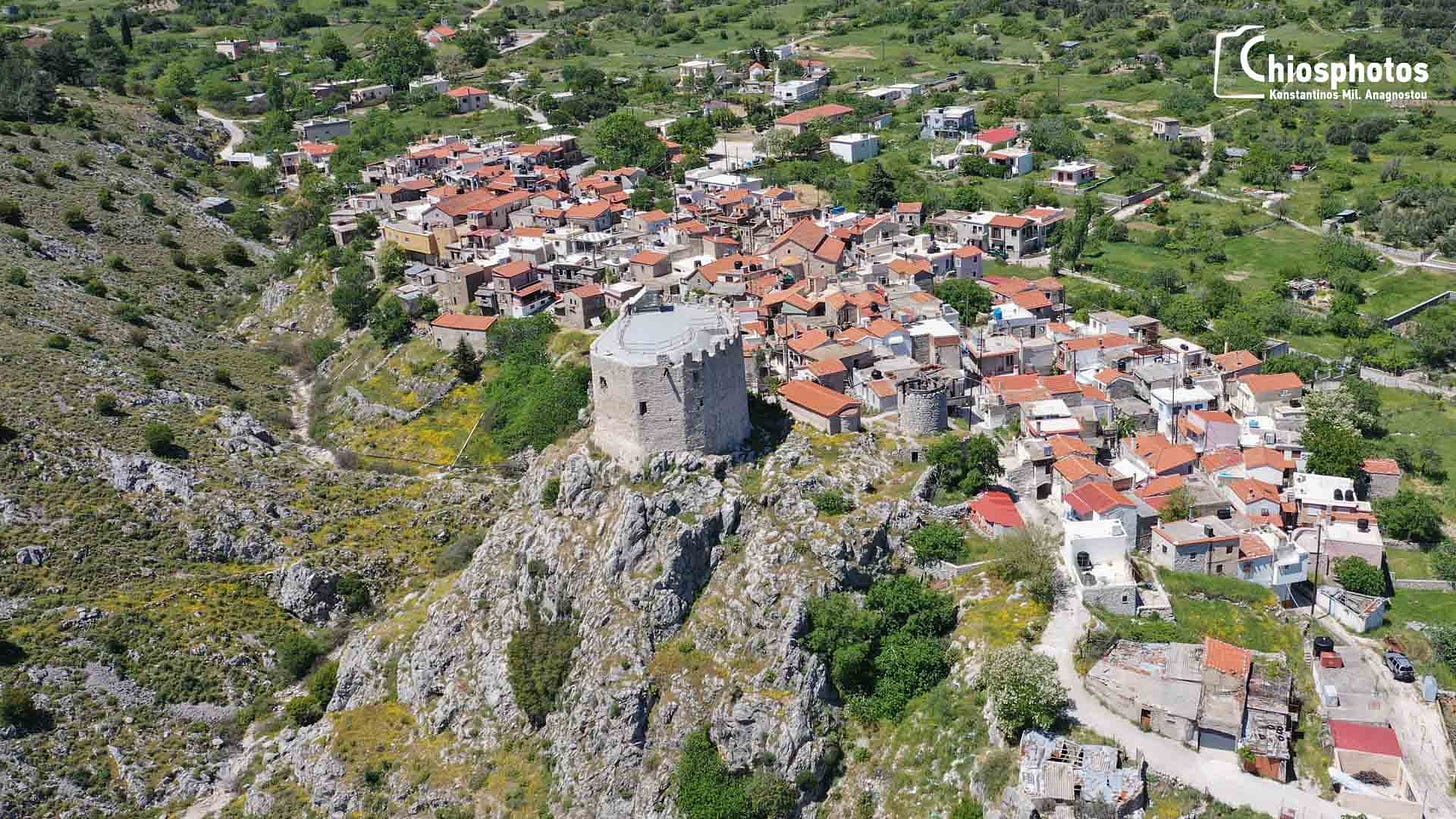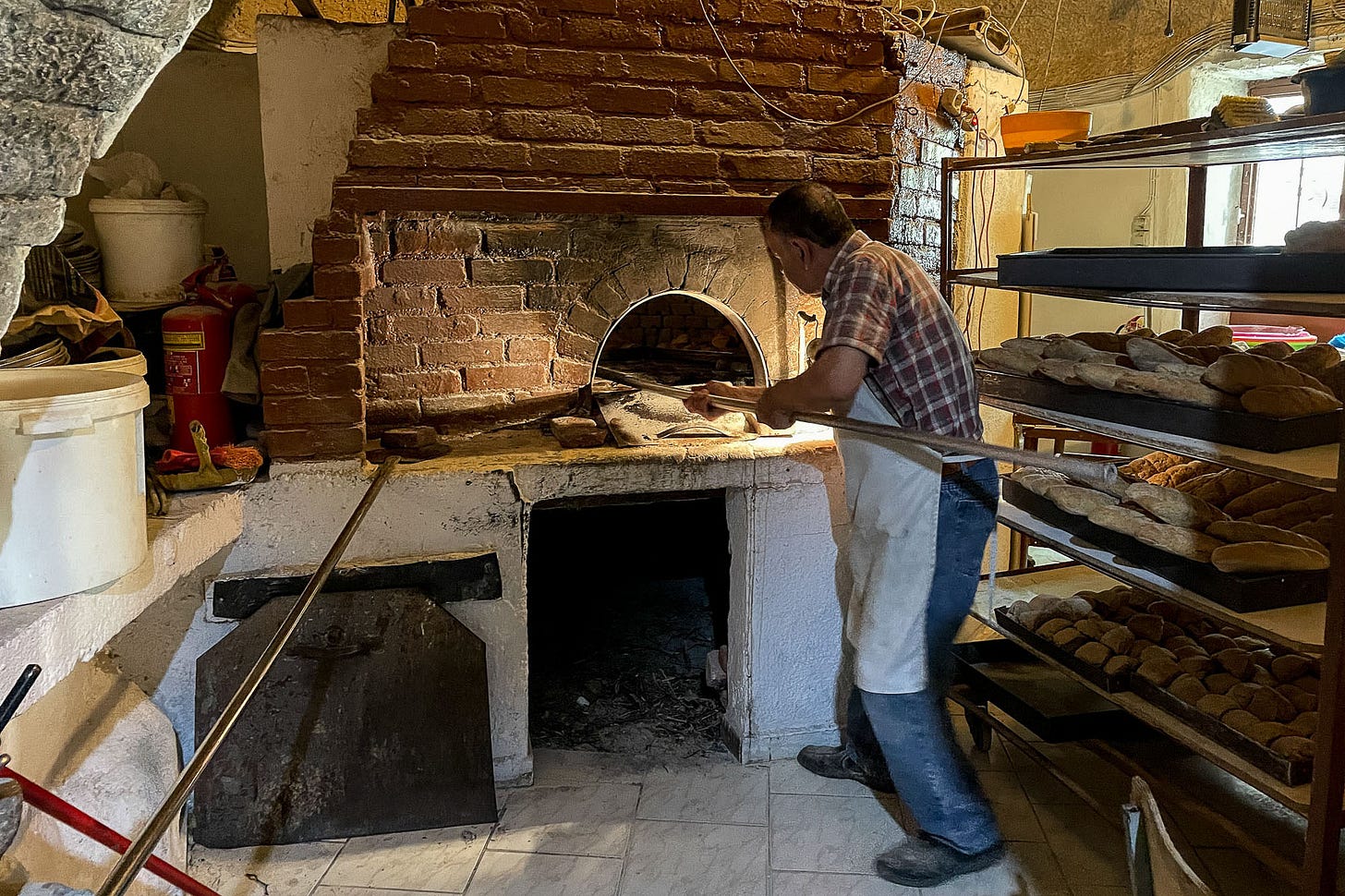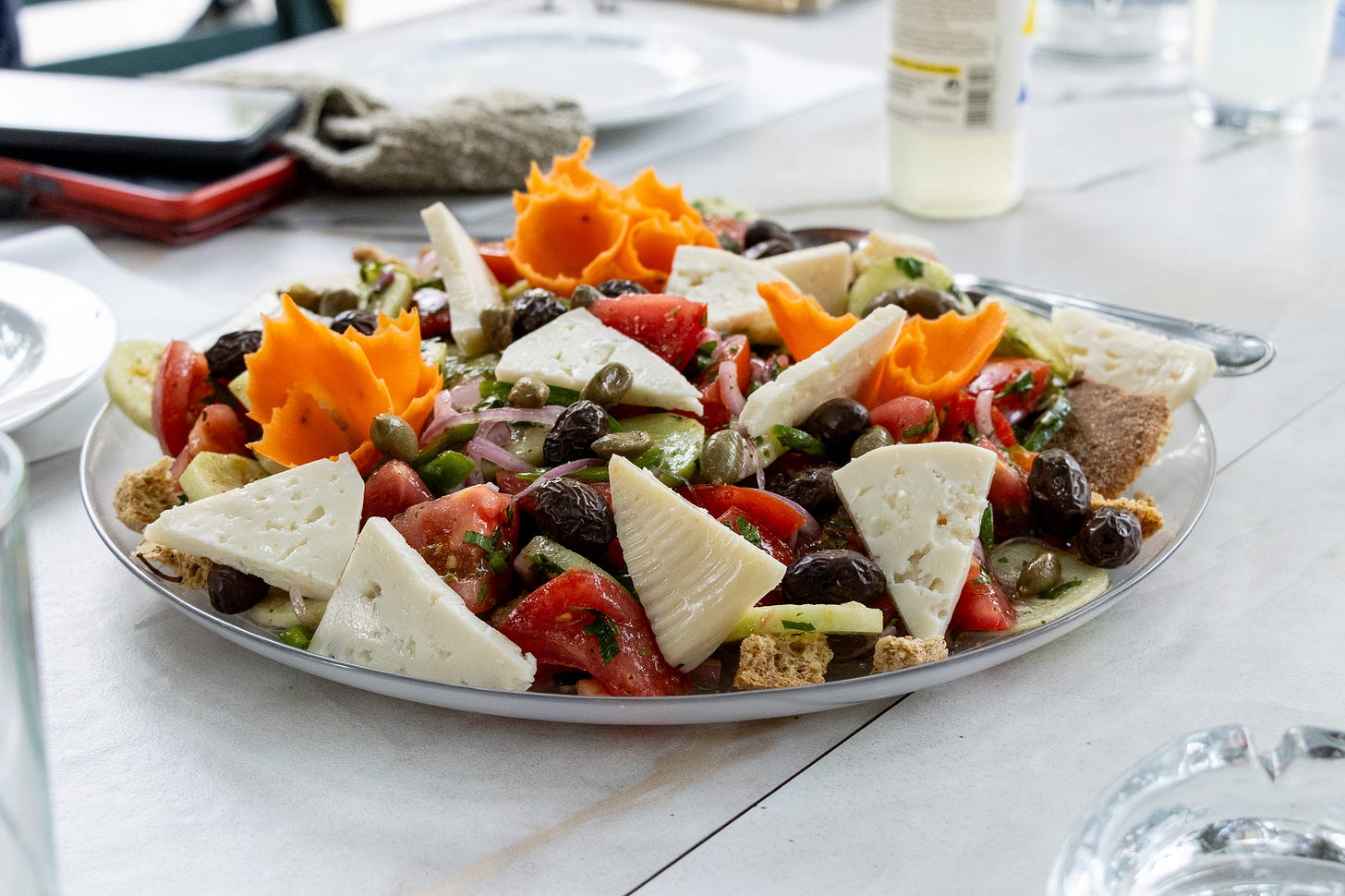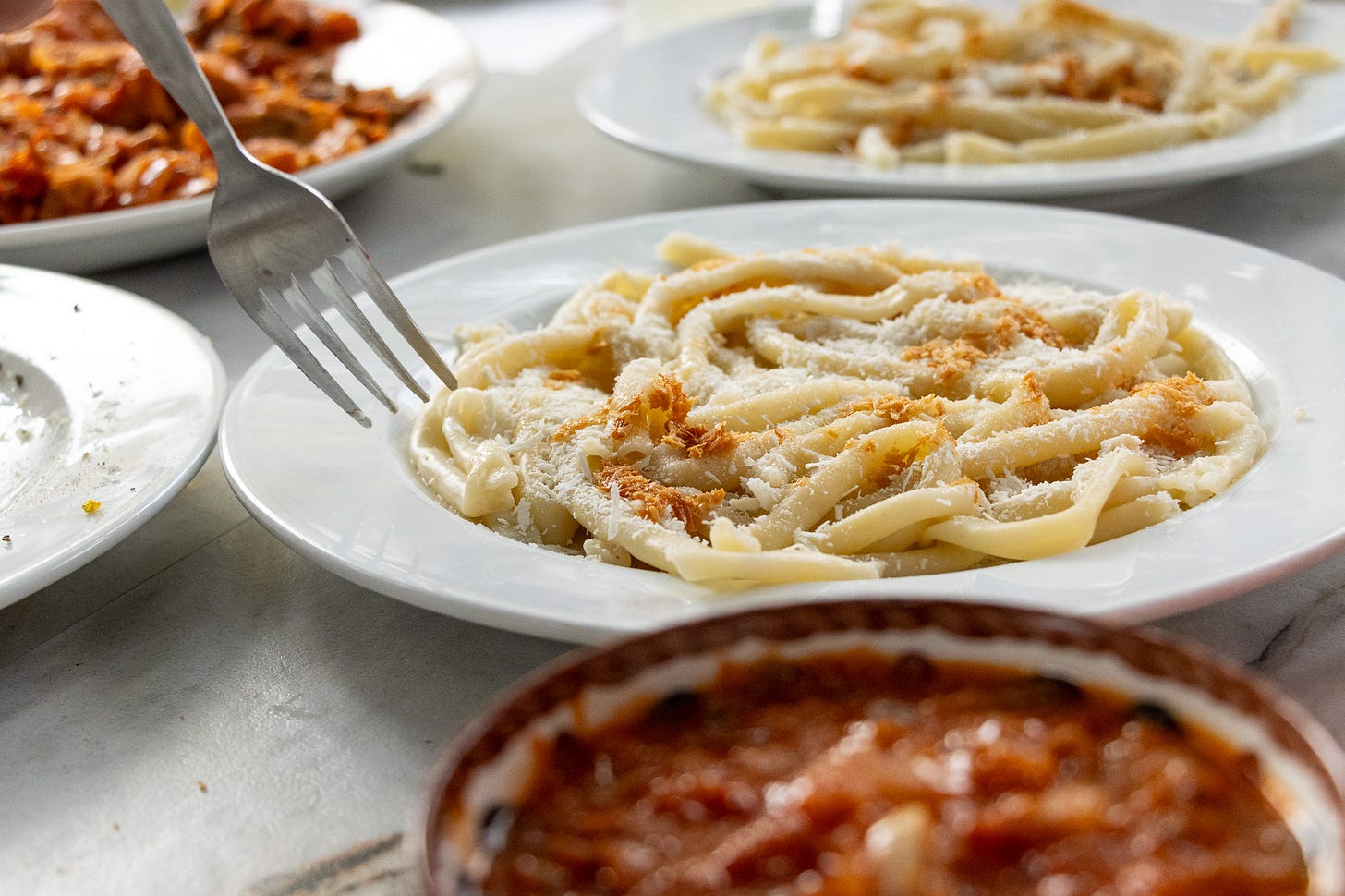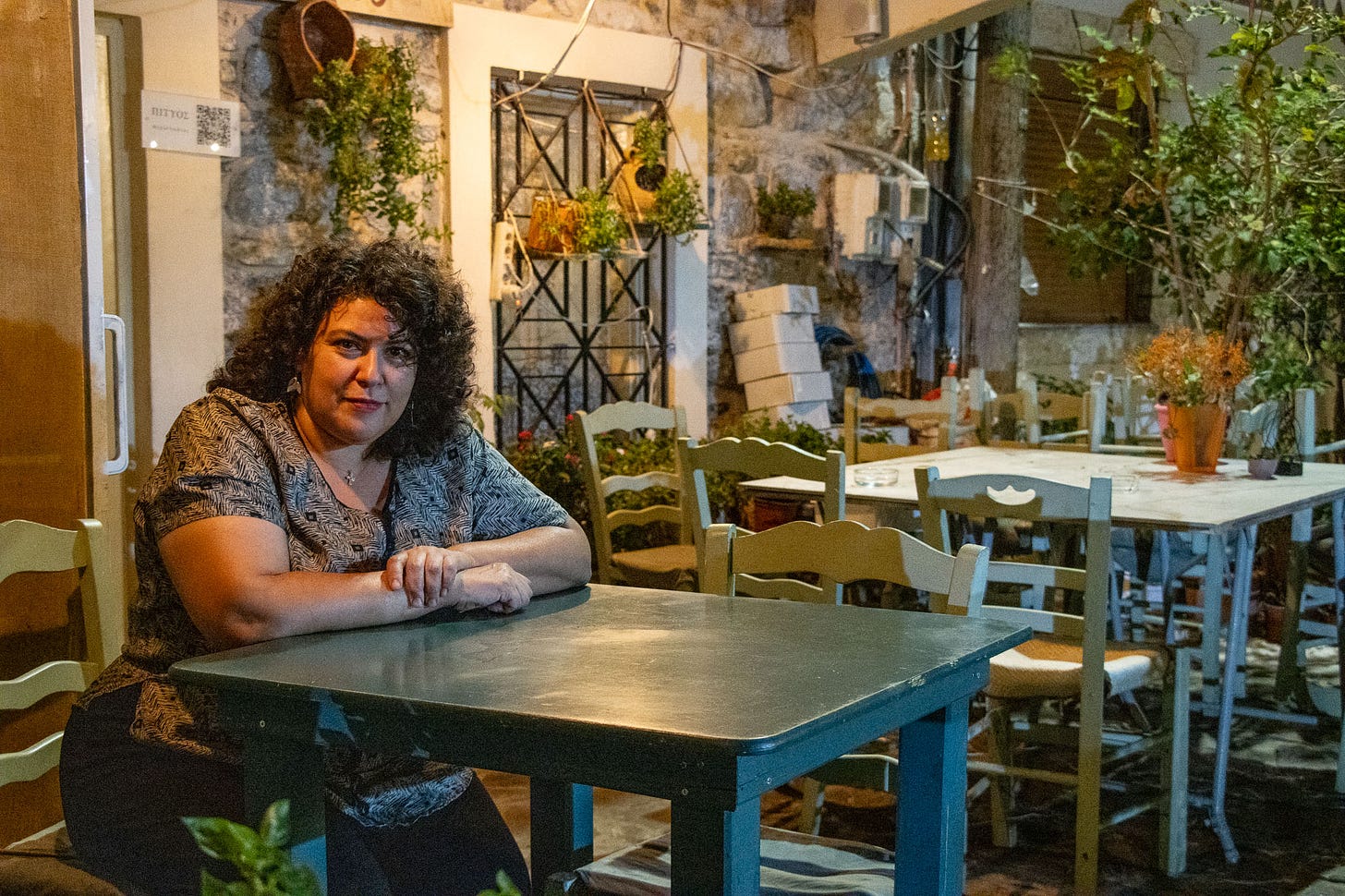In a remote Greek village, fresh and vibrant local flavors
In Pitios, on the island of Chios, O Cafenes tou Giorgi draws from old tradition.
As our rental car climbed the switchbacks along the coastal road leading from the main town to the remote, medieval village of Pitios on the Greek island of Chios, my husband Andreas and I debated whether to turn back. We had been invited to lunch—or was it dinner?—by local friends, but the plans were hazy. We weren’t sure what time we were supposed to show up. “In the afternoon,” Angeliki told us, which in Greece can mean any time from 2 p.m. to 9 p.m. Returning to the northeastern Aegean island two years after my ICWA fellowship, I found I had to readjust to island life.
Pitios is located on the southern slopes of Mount Pelineon, some 26 kilometers northwest of Chios town. It derives its name from either the Greek word for “pine,” pítis, or Pitioúsa, the island’s ancient name, meaning “pine-covered.” According to local lore, Homer stopped there before he began teaching in the northern village of Volissos. Today, Pitios has 40 permanent residents.
Although I’d lived on Chios for six months, it was only my second visit to Pitios. Our friends Angeliki and Antonis had lured us there with the promise of an incredible meal at Evi Katsioni’s O Cafenes tou Giorgi, a cafe in the village’s central square. Evi was collaborating with Antonis on a video series called Cooking Stories, traveling the island to discover local recipes and learn their histories.
“She cooks from the heart,” Antonis told me, kissing his fingertips. A self-taught cook, Evi made cuisine based on local flavors. The menu changed daily, depending on what was fresh.
We parked in the empty main square—one of the many perks of visiting Chios off-season—and I found Evi preparing food in the kitchen. Like my husband, she was born in Athens and had spent summers in Chios as a child. Ten years ago, her uncle Giorgi suggested she open a traditional coffee shop in the village; the cafe takes his name. Evi greeted us warmly, assured us our friends were on their way and suggested we explore the village.
We followed the seductive smell of baking bread to the wood-fired oven of Ioannis Apostolis. He once worked as a sailor—not unusual on this island, which played an outsized role in the development of Greece’s shipping industry—and then at his brother’s restaurant in Indianapolis before returning to Chios to open a bakery. We bought a sourdough loaf, and he gave us a bag of crispy rusks he had made by double-baking the day’s unsold bread.
Andreas and I set out on foot toward the recently renovated tower of Pitios, a medieval, 16-sided defensive structure built to control the route from Volissos to the village of Kardamyla. Walking through the narrow, twisting alleys and stone archways reminded me of Olympoi, one of the medieval villages of southern Chios where I’d lived as an ICWA fellow. Indeed, a series of paintings on doorways and windows were by the same artist, Babis Kiliaris, who had decorated Olympoi.
We also found QR codes on walls throughout the village. When we scanned them, we heard villagers singing traditional songs, the sounds of earlier days.
At the tower, we climbed to the roof and looked out over the village. It stood on the edge of a dry ravine, nestled between gray limestone hills covered by brown scrub and copses of pine trees. In the tower’s dim, vaulted chambers, we read about the history of the structure and the many artifacts gathered at the site, including a clay board game.
Our friends had arrived by the time we returned to O Cafenes tou Giorgi, and Evi had arranged a big table for us in the square under a tree festooned with lightbulbs and ornaments. Then she took us on a gastronomic tour of the village, bringing out a parade of colorful dishes.
“In Pitios, flavors always have a story behind them,” she told me. “Eating was never just a daily routine. It was a way for us to get together, communicate, love each other and laugh about all kinds of things.”
First came Evi’s take on a Greek salad, made with vegetables from her uncle’s garden: tomatoes grown mere meters from our table, a special variety of crunchy cucumber found only on Chios, olives and oil from Evi’s trees, orange flares of rolled carrot, local rusks and triangles of goat cheese, and instead of capers, pickled pistachios from the Saronic island of Aegina. The breathtaking freshness and vibrant flavor made me savor each bite. Evi told us that before they had refrigerators, villagers dried tomatoes and thick slices of zucchini in the sun and hung them from the ceilings of their houses “like necklaces” to consume throughout the winter.
After a beetroot and apple salad heaped on a bed of skordalia, a Greek puree made from walnut, potato and garlic, Evi served a platter of four different hand pies. Two contained cheese, following traditional village recipes: one with goat cheese and eggs from Evi’s chickens, the other with soft mizithra cheese, rice, mint and fennel. The other pies showed Evi’s creative flair: one had finely chopped pieces of pastirma, a wind-cured meat common in Anatolia, with lots of vegetables and cheese, and the other had goat meat sautéed with goat cheese, caramelized onions, and red and green peppers. I glanced around the table to make sure everyone had taken a pie before grabbing another.
Goat and lamb meat is plentiful in Pitios, which hosts a livestock festival every summer at the end of July. Goat is cooked at weddings, served with homemade pasta, or eaten with a hunk of bread as a treat. The village also produces various types of cheese from goat’s and sheep’s milk.
Evi lovingly described each dish. Cabbage rolls stuffed with rice, herbs and lemon cream. Zucchini cut into thin slices, lightly fried with a crispy crust. Thick slices of Chios potatoes seasoned with wild sage, coarsely ground pepper, garlic, lemon zest and grated goat cheese. Her cooking was full of kéfi, a quintessential Greek word meaning “spirit, passion, the joy of life.”
She strives to preserve the stories and traditions linked to each recipe. Before she brought out the handmade pasta, one of the village specialties, she demonstrated how each piece was made, rolling a simple dough of flour and water between her palms, around the stem of a broom plant. Women still roll each piece by hand, sitting on the steps in front of their homes, sharing news and gossip. The pasta is dried and boiled, then served with grated goat cheese and cheese fried in olive oil. Along with the handmade pasta, Evi served rooster in an aromatic red sauce of chopped cherry tomatoes and onion. The rooster was Evi’s own bird, and it was tender and perfectly complemented Pitios’s signature dish.
Evi is creating a gastronomic archive of recipes and stories that represent the identity of each village on the island. “You don’t just learn about the old ways, you live them in the present,” she said.
As the meal progressed, I found myself letting go of my sense of the clock, surrendering to the delicious meal and warm company. It felt as though the kéfi of Evi’s cooking rekindled my own. I sensed the great love and care she invested in every aspect of the cafe, from the fresh, seasonal ingredients in each dish to the way she decorated her corner of the square with plants and flowers. Instead of a customer, I felt like a guest in her home, one she was eager to impress with the very best of her kitchen.
“The cafenes is the soul of a village,” Evi said. “You go there to sit and drink your coffee, and they make it for you before you order because they know what you like. You go there alone, and you know you will find someone to talk to and pass the time. It’s where you go for a beer after work, where you can leave something for someone else to pick up, where you call to find out when the postman is due or why the church bell is ringing and who has died.”
As the sun set, Evi brought out a final surprise: a platter of chocolate-covered crêpes with huge scoops of vanilla ice cream. Belly full, cheeks sore from laughter, I settled into my chair, letting my friends’ stories carry me into the evening.
Other culinary attractions in Pitios:
Makellos: A picturesque taverna in the shade of a centuries-old plane tree run by former journalist Nikos Georgoulis.
Pitys Herbs: A family-run business that cultivates and processes Chian herbs like thyme, oregano, sage and savory—perfect for gifts.
Kafeglykopoleio tis Annas: Located on the road from Chios town to Pitios, Anna’s coffee and sweet shop is a cozy rest stop that offers traditional sweets like baklava and orange pie. Her homemade praline ice cream topped with chopped, caramelized almonds is out of this world.
Steven Tagle is a writer living in Switzerland. He was an ICWA Stavros Niarchos Foundation Fellow in Greece (2021-2023) based in the Evros region and islands of Chios and Crete, from where he explored the culture, history and economies of the country’s border zones and their importance to national politics, society, economics and geopolitics, including Greece’s mounting role in the Eastern Mediterranean and transatlantic alliance.



